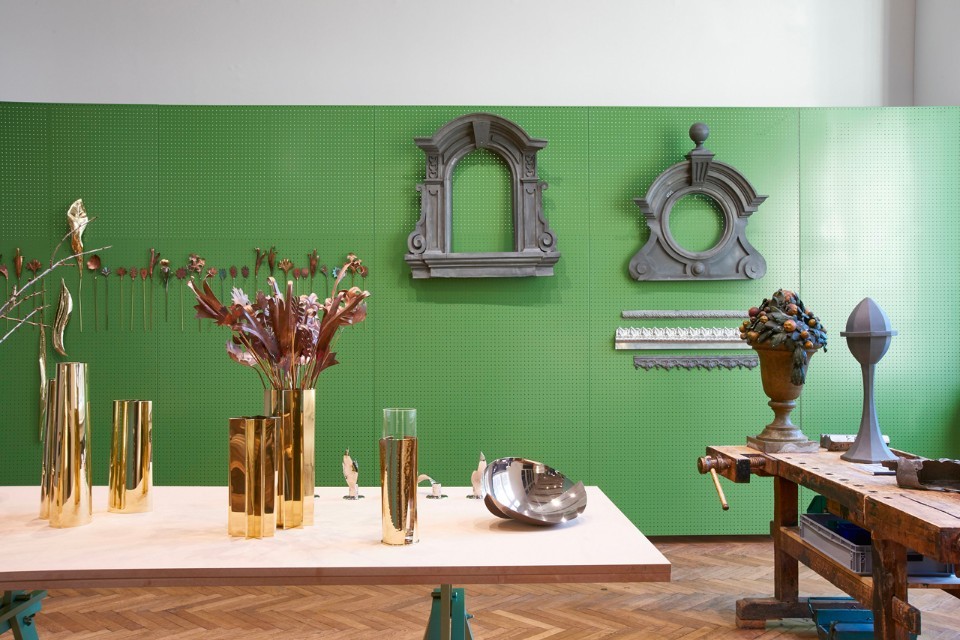Handicraft
Traditional Skills In The Digital Age
14 Dec 2016 - 09 Apr 2017
HANDICRAFT
Traditional Skills In The Digital Age
14 December 2016 - 9 April 2017
Guest Curator: Tina Zickler
Curator: Rainald Franz, Curator, MAK Glass and Ceramics Collection
The MAK exhibition handiCRAFT: Traditional Skills in the Digital Age reflects on the significance and status of handicraft as an integral component of material culture and cultural identity. In six sections, this comprehensive MAK exhibition encompasses handicraft from historical times to current European perspectives, examines how handicraft can help preserve natural resources, explores new developments on the interface to digital technologies, and presents masterpieces from a range of craft disciplines.
Currently the terms “handicraft” and “handmade” are used in an inflationary manner in advertising and lifestyle media. The Maker Movement and DIY culture are enormously successful, creating a worldwide hype. Globally operating luxury labels explicitly foreground handicraft as a mark of quality and distinction, in contrast to the reality of locally operating craftspeople struggling for recognition and a fair wage.
In the introductory exhibition section, “Past and Present,” a wide range of exhibits—from Hephaestus, the god of blacksmiths, to personal objects owned by the Hapsburgs, to the Chanel outfits of the 2014/15 Métiers d’Art Collection—discursively illustrate the social status of handicraft over the centuries.
Under the title “Perspectives,” the second exhibition section presents European initiatives and institutions active in the fields of apprenticeship and marketing, to include the Crafts Council and the Compagnons du Devoir.
The section “Materials and Tools” presents a wide range of material samples and 99 work tools, mostly originating from the 16th and 17th centuries. A walk-through installation offers visitors the haptic experience of handling different samples of natural materials.
In a “Live Workshop,” the fourth exhibition section, a total of 20 craftspeople demonstrate their skills to the public daily.
Craftspeople in the Live Workshop >>
Tue–Sun, 10 a.m.–1 p.m. and 2–6 p.m., Craftspeople in the Live Workshop
Tue, 6–10 p.m., MAK Conservation live
The fifth exhibition section, “Quality and Excellence,” juxtaposes historical objects from the MAK collection with contemporary handicraft products from 18 European countries. Exhibits include furniture, wallpapers, tiles, carpets, clothing, hats, gloves, glasses, cutlery, and tableware made by 50 craftspeople.
The final exhibition section is devoted to the key factor of “Sustainability.” To raise consumer awareness of product biographies, six handcrafted products made in Vienna are presented together with comprehensive information on the materials used and the manufacturing process. This section is complemented by a research lab set up by the Vienna University of Economics and Business and a video interview with the sociologist Richard Sennett, whose book The Craftsman provided significant inspiration for the exhibition.
The exhibition is accompanied by a publication of the same name, containing contributions and interviews with handicraft experts and craftspeople. Available at the MAK Design Shop.
Traditional Skills In The Digital Age
14 December 2016 - 9 April 2017
Guest Curator: Tina Zickler
Curator: Rainald Franz, Curator, MAK Glass and Ceramics Collection
The MAK exhibition handiCRAFT: Traditional Skills in the Digital Age reflects on the significance and status of handicraft as an integral component of material culture and cultural identity. In six sections, this comprehensive MAK exhibition encompasses handicraft from historical times to current European perspectives, examines how handicraft can help preserve natural resources, explores new developments on the interface to digital technologies, and presents masterpieces from a range of craft disciplines.
Currently the terms “handicraft” and “handmade” are used in an inflationary manner in advertising and lifestyle media. The Maker Movement and DIY culture are enormously successful, creating a worldwide hype. Globally operating luxury labels explicitly foreground handicraft as a mark of quality and distinction, in contrast to the reality of locally operating craftspeople struggling for recognition and a fair wage.
In the introductory exhibition section, “Past and Present,” a wide range of exhibits—from Hephaestus, the god of blacksmiths, to personal objects owned by the Hapsburgs, to the Chanel outfits of the 2014/15 Métiers d’Art Collection—discursively illustrate the social status of handicraft over the centuries.
Under the title “Perspectives,” the second exhibition section presents European initiatives and institutions active in the fields of apprenticeship and marketing, to include the Crafts Council and the Compagnons du Devoir.
The section “Materials and Tools” presents a wide range of material samples and 99 work tools, mostly originating from the 16th and 17th centuries. A walk-through installation offers visitors the haptic experience of handling different samples of natural materials.
In a “Live Workshop,” the fourth exhibition section, a total of 20 craftspeople demonstrate their skills to the public daily.
Craftspeople in the Live Workshop >>
Tue–Sun, 10 a.m.–1 p.m. and 2–6 p.m., Craftspeople in the Live Workshop
Tue, 6–10 p.m., MAK Conservation live
The fifth exhibition section, “Quality and Excellence,” juxtaposes historical objects from the MAK collection with contemporary handicraft products from 18 European countries. Exhibits include furniture, wallpapers, tiles, carpets, clothing, hats, gloves, glasses, cutlery, and tableware made by 50 craftspeople.
The final exhibition section is devoted to the key factor of “Sustainability.” To raise consumer awareness of product biographies, six handcrafted products made in Vienna are presented together with comprehensive information on the materials used and the manufacturing process. This section is complemented by a research lab set up by the Vienna University of Economics and Business and a video interview with the sociologist Richard Sennett, whose book The Craftsman provided significant inspiration for the exhibition.
The exhibition is accompanied by a publication of the same name, containing contributions and interviews with handicraft experts and craftspeople. Available at the MAK Design Shop.

